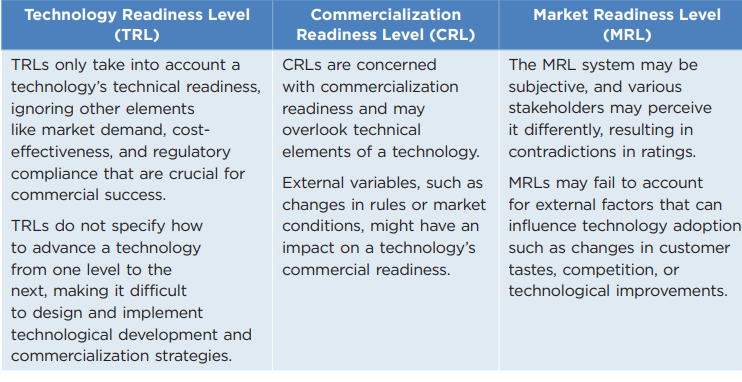Important Facts For Prelims
NITI Aayog Unveils TCRM Matrix Framework
- 22 Jul 2023
- 6 min read
Why in News?
NITI Aayog has introduced the Techno-Commercial Readiness and Market Maturity Matrix (TCRM Matrix) framework, an innovative assessment tool aimed at transforming technology evaluation, encouraging innovation, and nurturing entrepreneurship in India.
What is TCRM Matrix?
- TCRM Matrix stands for Techno-Commercial Readiness and Market Maturity Matrix.
- It is an assessment tool designed to revolutionize technology evaluation, foster innovation, and fuel entrepreneurship in India.
- The framework presents an integrated assessment model that offers in-depth insights and actionable intelligence to stakeholders at every stage of the technology development cycle.
How will TCRM Matrix be Useful?
- TCRM framework provides a robust analysis of the joint readiness of a project.
- The scale is intended to give a standard language for innovators, researchers, and investors to communicate about the readiness of a technology for commercialization or deployment.
- The Technology Readiness Level (TRL) was designed to give a framework for assessing a technology’s readiness and communicate more effectively about the risks and opportunities associated with a given technology by utilizing standard language to express the maturity of a technology.
- This framework was developed from the study of innovation from an economic perspective and looks at the increase in performance of a technology over time.
- It finds that from the point of introduction of the technology by an innovator, the improvement in performance of a technology usually starts very slowly with early adopters.
- The Commercialization Readiness Level (CRL) will assess various indicators which influence the commercial and market conditions beyond the technology maturity.
- It assess how a new technology could be commercially successful all the way through to commercial availability and wider acceptance within the target market.
- This enables key barriers to be addressed to support the commercialization of a technology.
- It is intended to supplement the TRL scale by providing increased focus on a technology’s preparedness for market launch and commercial success through specific and clearly defined business indicators.
- Market Readiness Level (MRL) is a methodology used to evaluate how close to the market the project outputs.
- It is used to assess how ready your product or service is to take to market as a commercial offering for a group of customers.
- It relies on extrinsic indicators like the awareness of extrinsic market indicators.
- It is intended to supplement the TRL and CRL by focusing on a technology’s preparedness for the purpose of customer adoption and market success
What are the limitations of TCRM Matrix?
- Each of the TRL, CRL, and MRL systems, have certain limitations which are:
Why is TCRM Matrix Needed?
- According to the Global Innovation Index 2022, India was ranked 40th in the world in terms of R&D expenditure as a percentage of GDP.
- India’s start-up ecosystem has grown rapidly, with over 50,000 start-ups in the country. This is supported by a strong network of incubators and accelerators, which have helped to nurture and support these innovative companies.
- The IT and software sector contributed USD 191 billion to India’s GDP in 2020, accounting for 7.7% of the country’s total GDP.
- The Indian pharmaceutical industry is the world’s third largest by volume, with over 20,000 registered companies.
Way Forward:
- The adoption of the TCRM Matrix framework necessitates a comprehensive analysis and contextualization within the unique national and sectoral innovation landscape. This will help policymakers in making effective decisions to foster innovation and drive growth.
What is the Global Innovation Index?
- The Global Innovation Index (GII), which is published annually by World Intellectual Property Organization (WIPO).
- The GII has also been recognized by the UN Economic and Social Council in its 2019 resolution on Science, Technology and Innovation for Development as an authoritative benchmark for measuring innovation in relation to the Sustainable Development Goals (SDGs).
What is WIPO?
- WIPO is the global forum for intellectual property (IP) services, policy, information and cooperation.
- It is a self-funding agency of the United Nations, with 193 member states.
- Its aim is to lead the development of a balanced and effective international IP system that enables innovation and creativity for the benefit of all.







